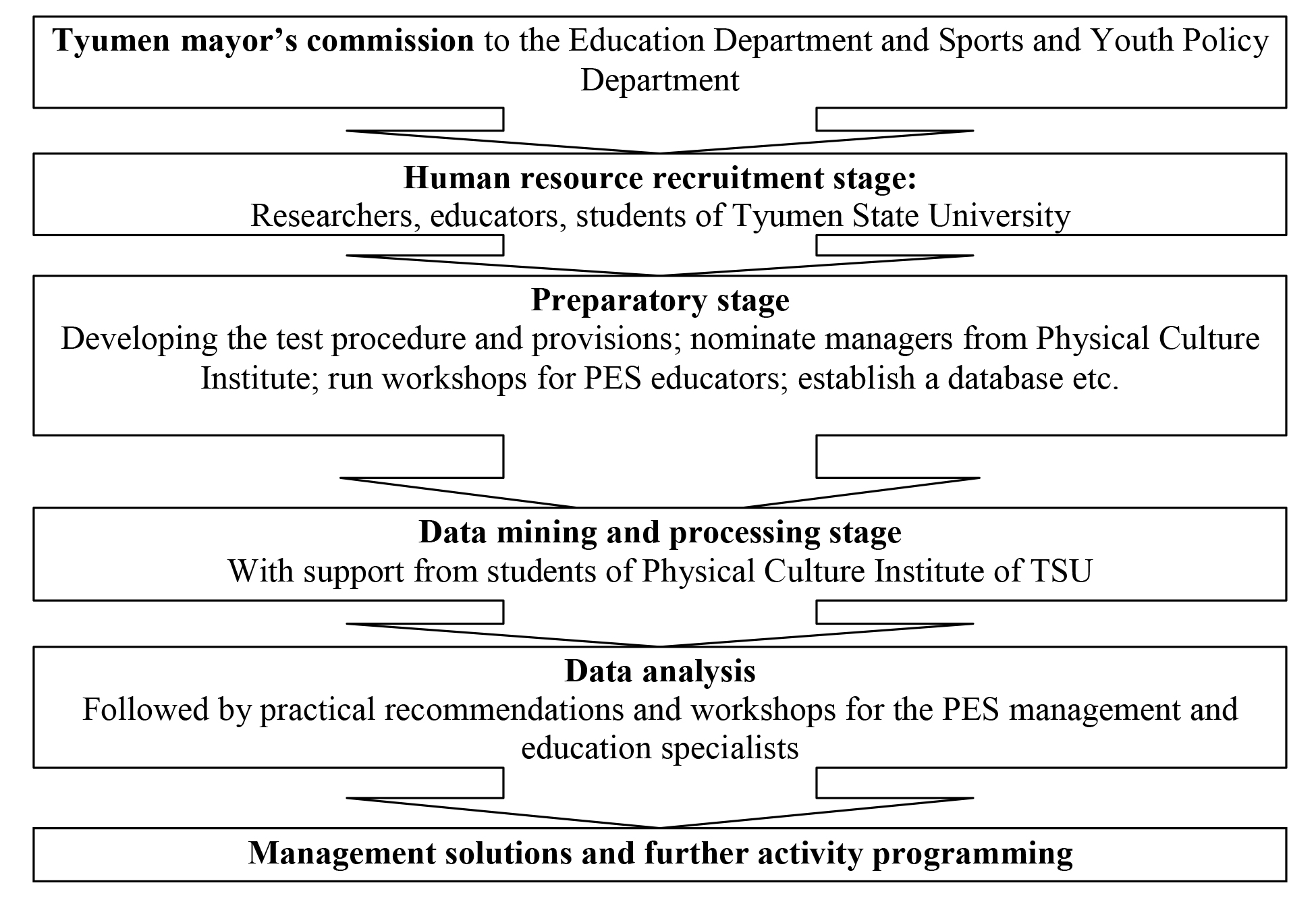Preschoolers’ physical health monitoring studies: problems and solutions
Фотографии:
ˑ:
PhD, Associate Professor T.P. Zavyalova1
PhD, Associate Professor I.V. Starodubtseva1
1Tyumen State University, Tyumen
Keywords: health monitoring studies, preschoolers’ physical health; 5-7 year old preschoolers, health monitoring problems, solutions.
Background. It was on the verge of the new millennium that the quality of the national education service was questioned and new mechanisms were required for the quality assessment with a high priority given to the process monitoring studies that were ranked among the most important education quality assessment instruments [1, 4, 6]. A special emphasis has been made on the children’s and adolescents’ health monitoring system and its components pursuant to the Russian Federal Government Decree #916 of 29.12.2001 “On the Russian people’s health and children’s, adolescents’ and youth physical development monitoring system” (hereinafter referred to as the “Decree”). It should be noted, although, that the existing monitoring system is still inconsistent in fact. The health monitoring system has established in some large cities (including Moscow, Saint Petersburg, Samara, Irkutsk and Yekaterinburg) and at a few educational establishments for the last few years.
Objective of the study was to pilot the 5-7 year-old preschoolers’ health monitoring system with a special emphasis on the upcoming system problems and potential solutions.
Methods and structure of the study. The fact-finding study was performed in the period of September 2015 to May 2016 at five preschool education establishments (PES) in Tyumen. Subject to the study were 1,283 preschoolers of 5-7 years of age including 628 boys and 655 girls.
Study results and discussion. The study data and analyses made it possible to identify the following key problems.
1. Still imperfect programmatic and regulatory framework for the preschoolers’ health monitoring at PES. Presently, the preschool education services are regulated by the relevant legal provisions including the Federal State Preschool Education Standard and PES education programs. However, these legal provisions, as verified by our analysis, provide too broad and vague frame for the educational process that sets loose outlines of potentially achievable process results rather than specific health and development goals. In addition, it is educational establishments that are kept responsible for the education quality assessments rather than the relevant individual education specialists. This requirement runs counter to the Federal Law “On the Physical Culture and Sports in the Russian Federation” (Article 28) of 04.12.2007 that requires the trainees’ physical fitness and development being monitored and rated on a daily basis. It should be emphasised that the health monitoring process in the national preschool education system is now regulated by the valid legal and regulatory provisions of the physical culture and sports sector rather than by the education sector. This might be the reason why virtually no initiatives have been lately taken at the national educational establishments in this domain.
2. Inconsistent requirements to the relevant test procedures and exercises, their content and numbers. Notwithstanding that the Decree sets forth a list of relevant tests exercises, the sector practitioners’ opinions on their applicability still widely differ and, hence, one to eight test exercises that are highly variable in quite a few aspects, are being actually applied in Tyumen kindergartens. The popular tests are dominated by the standing long jumps applied by 93.2% of the Tyumen PES; long throws (89.32%); 30m sprints (88.35%); standing bends forward (74.76%); shuttle sprints (69.9%); 300m races (68%) and sit-ups (65.05%). Most of the relevant specialists tend to rate the preschoolers’ health by a few key movements rather than the physical development and quality rates in fact.
Moreover, the sets of test exercises are largely determined by the sport equipment and facilities actually available at the kindergartens. As was found by the study, only 33% of the municipal kindergartens have a separate room for sports; whilst 62% use combined sport facilities and 5% totally lack them. Furthermore, 17% of the kindergartens do not have access to sport grounds; and 25% and 65% are in need of quality run tracks for the 30m sprints and 300m races, respectively [5].
This situation complicates mass physical examinations, tests and comparative studies of different PES. This is the reason why a uniform physical fitness testing and data analyzing procedure and system need to be developed. It was for the last few years that a research team of the Theoretical Basics of Physical Education Sub-department of Tyumen State University has worked in this field and developed their preschoolers’ physical health monitoring system designed to generate physical fitness, physical development and functionality data [3].
The physical fitness was rated using 30m/ 300m runs; standing long jumps; 30-second sit-ups; 3х10m shuttle sprints; and standing bends forward that altogether make it possible to rate the key physical qualities of kindergarten leavers. The physical development was rated by the body anthropometrical measurements used to compute Kettle-2 body mass index; and functionality was rated by spirometry and dynamometry to obtain the vital capacity and wrist strength data. The test model was discussed in practical workshops with the kindergarten instructors to work out practical recommendations and analyse the model applicability and quality to secure the children’s physical development data being the most relevant and helpful.
3. Inconsistent approaches to data processing, interpretation and relevant standards that need to be updated on a regular basis. The relevant provisions offered in the available publications are (1) outdated; (2) offer different test standards (from three to seven); (3) widely different; and (4) designed and applied in the areas much different from the Tyumen region in the climatic, socio-economic and other aspects. Therefore, we had to combine a few standards to apply them for the reference purposes to generate the relevant physical health data.
4. System design and management process challenges that inevitably come up in the large-scale studies. In Tyumen this problem was solved by due cooperation of the municipal authorities, researchers, students of Physical Culture Institute of Tyumen State University and PES management and educators. This synergy made it possible to efficiently and effectively design the study and mine the relevant data. Given in Figure 1 hereunder is the monitoring system design and management structure.

Figure 1. Monitoring system design and management structure
5. Problem of programmatic and IT support for the system. The Tyumen preschoolers’ physical fitness monitoring system piloting experience showed the need for the relevant IT products for progress of such studies and systems [2]. The system designers and implementers strived to both develop a highly efficient computerised Senior Preschoolers’ Psychophysical Development Monitoring System and improve the IT culture of the relevant PES instructors and practitioners. With this purpose, the monitoring system implementation process was designed to include a set of education workshops for the relevant PES specialists to help them master the test software. The process resulted in every relevant municipal PES being equipped with the software toolkit that gives the means to obtain, store, analyse and report test data and, hence, step up the physical education and health improvement activity at kindergartens.
Conclusion. The Tyumen preschoolers’ physicality and health monitoring study found a few key problems for the system implementation including: still imperfect regulatory, programmatic and IT provisions for the system design and content to be efficient. The problems were successfully solved by the cooperative efforts of the Sports and Youth Policy Department and Education Department of the Tyumen Municipal Government initiated by the Mayor; and due contribution from the researchers and students of Physical Culture Institute in mining objective and informative data on the 5-7 year old Tyumen preschoolers’ health, functionality and physicality.
References
- Izaak S.I. Monitoring fizicheskogo razvitiya i fizicheskoy podgotovlennosti: teoriya i praktika [Monitoring of physical development and physical fitness: theory and practice]. Moscow: Sovetskiy sport publ., 2005, 195 p.
- Zavyalova T.P. Monitoring fizicheskoy podgotovlennosti doshkolnikov Tyumeni: pervye rezultaty, pervye obsuzhdeniya [Monitoring of Tyumen physical fitness: first results, first discussions]. Teoriya i praktika fiz. kultury, 2005, no. 8, pp.17-19.
- Zavyalova T.P., Starodubtseva I.V. Metodicheskie rekomendatsii k monitoringu fizicheskoy podgotovlennosti doshkolnikov [Methodical recommendations for preschoolers' physical fitness monitoring]. Tyumen: Vector Book publ., 2004, 30 p.
- Semenov L.A. Sostoyanie konditsionnoy fizicheskoy podgotovlennosti detey – vypusknikov doshkolnykh obrazovatelnykh organizatsiy v kontekste realizatsii trebovaniy FGOS [Conditioning physical fitness of graduates of preschool educational institutions within implementation of FSES requirements]. Fizicheskaya kultura: vospitanie, obrazovanie, trenirovka, 2016, no. 1, pp. 26-29.
- Starodubtseva I.V., Zavyalova T.P. Psikhofizicheskiy portret sovremennogo vypusknika detskogo sada (na primere tyumenskogo regiona) [Psychophysical profile of modern kindergarten graduate (case study of Tyumen region)]. Tyumen: TSU publ., 2017, 112 p.
- Tretyakov P.I., Sharay N.A. K voprosu o sostoyanii problemy upravleniya kachestvom obrazovatelnykh sistem [On educational system quality management]. Znanie. Ponimanie. Umenie, 2012, no. 4, pp. 295-300.
Corresponding author: mangeley60@mail.ru
Abstract
The study lists and analyses the physical health problems diagnosed in the sample of 1,283 preschoolers of 5-7 years of age attending preschool establishments in Tyumen. It was found that health monitoring in kindergartens is associated with a few problems including: still imperfect regulatory and programmatic provisions; need for the test procedures being unified; still inadequate test exercises complicating mass health monitoring initiatives and comparative studies involving a few kindergartens; selection of rating criteria and analyses of health data; and existing institutional, management, IT support and programmatic problems.
The study data and analyses made in possible to offer the following measures to improve the 5-7 year-old preschoolers’ health monitoring in Tyumen kindergartens: (1) Cooperative efforts of the municipal agencies under leadership of the Sports and Youth Policy Department and Education Department; (2) Due contribution from the researchers that designed the 5-7 year-old preschoolers’ health monitoring and test system including physical fitness tests (30m/ 300m runs; standing long jumps; 30-second sit-ups; 3х10m shuttle sprints; standing bends forward), anthropometrical measurements and functionality tests (spirometry and dynamometry to compute Kettle-2 body mass index); with support from the local Physical Culture Institute students to ensure objective data mining for the studies; and (3) Modern software tools to obtain, process and analyse the relevant health test data.



